Mineralization Based on CSAMT and SIP Sounding Data: A Case Study on the Hadamengou Gold Deposit in Inner Mongolia
Abstract
:1. Introduction
2. Regional Tectonics and Metallogenic Background
3. Data Acquisition and Processing
3.1. Data Acquisition
3.2. Data Processing and Inversion
3.3. Electrical Characteristics of the Profile
4. Geological Interpretation and Discussion
4.1. Relationship between the Resistivity and Frequency Dispersivity
4.2. Geological Interpretation
4.3. Discussion
5. Conclusions
- (1)
- Using the data of four CSAMT and SIP profiles in the Hadamengou mining area, the underground resistivity model and the pseudo-section map of the apparent frequency dispersivity were obtained by fine inversion.
- (2)
- In the resistivity model, there were two high-resistivity blocks with resistivity values greater than 3000 Ω m and three low-resistivity channels with resistivity values less than 50 Ω m. Combined with regional geological and drilling data, it was inferred that the high-resistivity bodies R4 and R5 are alkaline magmatic intrusions, which are related to multiple stages of magmatic hydrothermal activities from the Precambrian to Yanshanian periods. The low-resistivity channels, C3, C5, and C4, might represent the Baotou–Hohhot fault, its secondary faults, and ductile shear zones and potassic alteration zones, respectively, which were formed in the Precambrian era and underwent multiple activation from the Hercynian to the Yanshanian periods. According to the spatial relationship, we hypothesize that the ductile shear zone is an important ore-controlling and ore-hosting structure. The Baotou–Hohhot fault may not be an ore-controlling fault, but a pre-metallogenic fault.
- (3)
- Comparing the resistivity model with the pseudo-section map of the apparent frequency dispersivity, it was found that all the known gold veins were located in the superimposed area of low resistivity and high-frequency dispersivity, and the ductile shear zone in the outer contact of alkaline magmatic rock body with the superimposed characteristics of low resistivity and high-frequency dispersivity was considered to be the favorable area for mineralization.
Author Contributions
Funding
Data Availability Statement
Conflicts of Interest
References
- Hart, C.J.; Goldfarb, R.J.; Qiu, Y.; Snee, L.; Miller, L.D.; Miller, M.L. Gold deposits of the northern margin of the North China Craton: Multiple late Paleozoic–Mesozoic mineralizing events. Miner. Depos. 2002, 37, 326–351. [Google Scholar] [CrossRef]
- Zhang, Y.M.; Gu, X.X.; Xiang, Z.L.; Liu, R.P.; Cheng, W.B.; Wang, X.L. Magmatic hydrothermal origin of the Hadamengou-Liubagou Au-Mo deposit, Inner Mongolia, China: Constrains on geology, stable and Re-Os isotopes. Ore Geol. 2017, 86, 172–195. [Google Scholar] [CrossRef]
- Zeng, Q.; Wang, Y.; Yang, J.; Guo, Y.; Yu, B.; Zhou, L.; Qiu, H. Spatial–temporal distribution and tectonic setting of gold deposits in the Northern margin gold belt of the North China Craton. Int. Geol. Rev. 2020, 63, 941–972. [Google Scholar] [CrossRef]
- Li, Z.; Liu, J.; Zhang, H.; Fan, K.; Zhang, X.; Deng, J.; Zhang, J. Multistage gold mineralization in the Hadamengou gold deposit in the northern margin of the North China Craton: Insights from in-situ trace element contents and sulfur isotope analyses of pyrite. Ore Geol. Rev. 2021, 134, 104135. [Google Scholar] [CrossRef]
- Gold Headquarter of Chinese Armed Police Force (GHCAPF). Geology of the Hadamengou Pegmatitic gold Deposit Occurring in Inner Mongolia Autonomous Region; Seismological Press: Beijing, China, 1995; pp. 1–227, (In Chinese with English Abstract). [Google Scholar]
- Zhang, Y.M.; Gu, X.X.; Cheng, W.B.; Dong, S.Y.; Huang, Z.Q.; Li, F.L.; Yang, W.L. Stable Isotopic Geochemistry of the Liubagou-Hadamengou Gold Deposit in Inner Mongolia. Acta Mineral. Sin. 2011, 31, 530–540, (In Chinese with English Abstract). [Google Scholar]
- Niu, S.Y.; Sun, A.Q.; Ma, B.J.; Jiang, S.H.; Nie, F.J.; Zhang, J.Z.; Wang, B.D.; Xia, D. Tectonic evolution and metallogenic ore-controlling tectonic characteristics of Hadamengou gold deposit in Inner Mongolia. Earth Sci. Front. 2015, 22, 223–237. [Google Scholar]
- Zhang, H.Y. Study on the Characterisitics of Ore-Controlling Structures in the Hadamengou Mining Area, Inner Mongolia. Master’s Thesis, Chinese Academy of Geological Sciences, Beijing, China, 2017; pp. 1–97, (In Chinese with English Abstract). [Google Scholar]
- Jia, S.H.; Wang, E.D.; Fu, J.F.; Wu, L.; Zhao, C.F. Indosinian gold mineralization and magmatic-hydrothermal evolution of the Hadamengou gold deposit at the northern margin of the North China Craton: Constraints from K-feldspar laser 40Ar/39Ar dating. J. Geochem. Explor. 2018, 190, 314–324. [Google Scholar] [CrossRef]
- Nie, F.J.; Bjorlykke, A. Lead and sulfur isotope studies of the Wulashan quartz-K feldspar and quartz vein gold deposit, southwestern Inner Mongolia, People’s Republic of China. Min. Depos. 1994, 89, 1289–1305. [Google Scholar] [CrossRef]
- Jia, S.H.; Fu, J.F.; Wang, E.D.; Men, Y.K. The Hadamengou K-feldspar–quartz vein-type Au mineralization in the northern margin of the North China Craton (China): An Indosinian oxidized intrusion-related Au–(Mo) system. Geochem. Explor. Environ. Anal. 2020, 20, 14–34. [Google Scholar] [CrossRef]
- Xu, X.C. Relation between the ductile shear retrogressive metamorphism and gold deposit in wulashan region, inner Mongolia. Miner. Resour. Geol. 1991, 5, 107–114. [Google Scholar]
- Zheng, F.S.; Xu, G.Q.; Feng, Z.; Zhang, Z.F.; Cai, H.J. Geological Characteristics and Prospective Value of Greenstone Type Gold Deposits of Central Part of Inner Mongolia Autonomous Area. Acta Geol. Sin. 2005, 79, 232–248, (In Chinese with English Abstract). [Google Scholar]
- Gan, S.F.; Qiu, Y.M.; Yang, H.Y.; Reenen, D.D.V. The Hadamengou Mine: A Typical Gold Deposit in the Archean Granulite Facies Terrane of the North China Craton. Int. Geol. Rev. 1994, 36, 850–866. [Google Scholar] [CrossRef]
- Zhang, Y.M. Metallogenesis, Ore-Controlling Factors and Prospecting Direction of the Liubagou-Hadamengou Gold Deposit, Inner Mongolia. Ph.D. Thesis, Chinese Academy of Geological Sciences, Beijing, China, 2012; pp. 1–253, (In Chinese with English Abstract). [Google Scholar]
- Hou, W.R.; Nie, F.J.; Zhao, G.M.; Chen, H.J.; Lei, S.B.; Wang, L. Sulfur and Lead Isotope Geochemistry Characters of the Hadamengou Gold Deposit in Inner Mongolia. Acta Geol. Sin. 2014, 88 (Suppl. S2), 1509–1510. [Google Scholar] [CrossRef]
- Zhang, Y.; Liu, J.C.; Zhang, H.D.; Zhang, S.P. Geological characteristics, and origin of the Hadamengou gold deposit in Inner Mongolia, China. Arab J Geosci. 2016, 9, 311–320. [Google Scholar] [CrossRef]
- Nie, F.J.; Jiang, S.H.; Liu, Y.; Hu, P. Re-discussions on the time limitation of gold mineralization occurring within the Hadamengou deposit, south-central Inner Mongolia autonomous region. Acta Petrol. Sin. 2005, 21, 1719–1728, (In Chinese with English Abstract). [Google Scholar]
- Wang, L.; Wang, G.H.; Lei, S.B.; Wei, G.F.; Jia, L.Q.; Chang, C.X. Re-Os dating of molybdenite from Hadamengou gold ore field in Inner Mongolia and its geological significance. Acta Geol. Sin. 2014, 88, 1017–1018. [Google Scholar] [CrossRef]
- Zhao, G.; Zhai, M. Lithotectonic elements of Precambrian basement in the North China Craton, review and tectonic implications. Gondwana Res. 2013, 23, 1207–1240. [Google Scholar] [CrossRef]
- Ma, B.J.; Niu, S.Y.; Chen, C.; Wang, B.D.; Sun, A.Q.; Zhang, J.Z. Evolution of the Tectonic Stress Field and Structural Controls on Ore Mineralization of the Hadamengou Gold Deposit in Inner Mongolia. Geotecton. Metallog. 2012, 36, 530–540, (In Chinese with English Abstract). [Google Scholar]
- Liu, D.W. Study on the characteristics of structural deformation and ore-controlling structure in Hadamengou gold mining area, Inner Mongolia. Ph.D. Thesis, Chinese Academy of Geological Sciences, Beijing, China, 2014; pp. 1–166, (In Chinese with English Abstract). [Google Scholar]
- Li, J.M.; Cai, S.B.; Zhu, D.F.; Guan, L.X. Geological characteristics and prospecting prediction of gold deposits in Wulashan area, Inner Mongolia. Gold Geol. 1993, 2, 14–20. (In Chinese) [Google Scholar]
- Goldstein, M.A.; Strangway, D.W. Audio frequency magnetotelluric with a grounded dipole source. Geophysics 1975, 40, 669–683. [Google Scholar] [CrossRef]
- Zonge, K.L.; Hughes, L.J. Controlled Source Audio-Frequency Magnetotelluric; Central South University Press: Changsha, China, 1990; pp. 5–59. (In Chinese) [Google Scholar]
- Hu, X.Y.; Peng, R.H.; Wu, G.J.; Wang, W.P.; Huo, G.P.; Han, B. Mineral exploration using CSAMT data: Application to Longmen region metallogenic belt, Guangdong Province, China. Geophysics 2013, 78, B111–B119. [Google Scholar] [CrossRef]
- Martin, T.; Günther, T.; Weller, A.; Kuhn, K. Classification of slag material by spectral induced polarization laboratory and field measurements. J. Appl. Geophys. 2021, 194, 104439. [Google Scholar] [CrossRef]
- Yang, W.; Chen, J.P.; Gu, X.X.; Xiang, J.; Zhang, Y.M. Application of 3D geological modelling based on geophysical data in the Hadamengou gold deposit in Inner Mongolia. J. Geol. 2016, 40, 501–506, (In Chinese with English Abstract). [Google Scholar]
- Chen, F.B. CSAMT Two-Dimensional OCCAM Inversion and Application. Master’s Thesis, Chinese Academy of Geological Sciences, Beijing, China, 2016; pp. 1–66, (In Chinese with English Abstract). [Google Scholar]
- Yang, Z.W.; Zheng, W.; Li, X.B.; Wang, H.F. The development and prospect of the spectral induced polarization method. Geophys. Geochem. Explor. 2015, 39, 22–28, (In Chinese with English Abstract). [Google Scholar]
- Wang, H.; Li, T.L.; Chen, H.B.; Wang, Y. 2D magnetotelluric forward modeling with induced polarization. Glob. Geol. 2018, 37, 1226–1230, (In Chinese with English Abstract). [Google Scholar]
- Zheng, B. Application of Spectral Induced Polarization to one Pb-Zn-Ag deposit. Chin. J. Eng. Geophys. 2015, 12, 750–754, (In Chinese with English Abstract). [Google Scholar]
- Shah, A.K.; Bedrosian, P.A.; Anderson, E.D.; Kelley, K.D.; Lang, J. Integrated geophysical imaging of a concealed mineral deposit: A case study of the world-class Pebble porphyry deposit in southwestern Alaska. Geophysics 2013, 78, B317–B328. [Google Scholar] [CrossRef]
- Ma, Z.B.; Yan, C.H.; Song, Y.W.; Wang, J.Z.; Si, F.Z.; Yang, R.X. Application of Combined Geophysical Methods CSAMT and SIP to the Survey of Concealed Metal Deposits in the Luanchuan Mountainous Area, Henan Province. Geol. Explor. 2011, 47, 654–662, (In Chinese with English Abstract). [Google Scholar]
- Peng, Y.; He, Y.L.; Zeng, T.; Zhong, J.W.; Xu, G.L.; Sun, X.J.; Chen, J.; Peng, S.M.; Li, Z. Regional Metallogenic and Synthetic Information Prediction Models of Mo Deposits in Henan Province, China. J. Jilin Univ. 2013, 43, 1262–1275, (In Chinese with English Abstract). [Google Scholar]
- Hao, X.Z.; Yang, Y.H.; Li, Y.P.; Wang, Q.Y.; Wang, Y.P.; Wang, L.G. Application of Integrated Ore Prognosis Method in Covered Area: A Case Study of Shanxian Iron Deposit in Shandong Province, China. J. Jilin Univ. 2013, 43, 641–648, (In Chinese with English Abstract). [Google Scholar]
- Zhang, H.T.; So, C.S.; Yun, S.T. Regional geologic setting and metallogenesis of central Inner Mongolia, China: Guides for exploration of mesothermal gold deposits. Ore Geol. Rev. 1999, 14, 129–146. [Google Scholar] [CrossRef]
- Liu, W.; Deng, J.; Chu, X.L.; Zhai, Y.S.; Xu, G.Z.; Li, X.J. Characteristics and geological background of formation of the large and giant ore deposits within the northern margin of the China platform. Prog. Geophys. 2000, 15, 67–78, (In Chinese with English Abstract). [Google Scholar]
- Zhai, M.G. Tectonic evolution and metallogenesis of North China Craton. Miner. Depos. 2010, 29, 24–36, (In Chinese with English Abstract). [Google Scholar]
- Zhang, S.H.; Zhao, Y.; Liu, J.M.; Hu, J.M.; Song, B.; Liu, J.; Wu, H. Geochronology, geochemistry, and tectonic setting of the Late Paleozoic-Early Mesozoic magmatism in the northern margin of the North China Block: A preliminary review. Acta Petrol. Mineral. 2010, 29, 824–842, (In Chinese with English Abstract). [Google Scholar]
- Wang, L.; Wang, G.H.; Lei, S.B.; Chang, C.J.; Hou, W.R.; Jia, L.Q.; Zhao, G.M.; Chen, H.J. Petrogenesis of Dahuabei pluton from Wulashan, Inner Mongolia: Constraints from geochemistry, zircon U-Pb dating and Sr-Nd-Hf isotopes. Acta Petrol. Sin. 2015, 31, 1977–1994, (In Chinese with English Abstract). [Google Scholar]
- Hou, W.R. Contrast Study on the Hadamengou Gold Deposit and Jinchanggouliang Gold Deposit, Inner Mongolia. Ph.D. Thesis, Chinese Academy of Geological Sciences, Beijing, China, 2011; pp. 1–213, (In Chinese with English Abstract). [Google Scholar]
- Li, Z.D.; Li, X.G.; Duan, C.; Chen, J.Q.; Wang, J.Y.; Yu, R.A.; Zhang, Q.; Wan, S.B.; Zhang, C. Helium and argon isotopic tracing for sources of ore- forming fluid in Hadamen’gou gold deposit, Inner Mongolia. Miner. Depos. 2018, 37, 521–534, (In Chinese with English Abstract). [Google Scholar]
- Rodi, W.; Mackie, R.L. Nonlinear conjugate gradients algorithm for 2-D magnetotelluric inversion. Geophysics 2001, 66, 174–187. [Google Scholar] [CrossRef]
- Zhang, Q.J.; Yang, J. The application of integrated electrical methods to the esploration of deep concealed ore bodies. Geophys. Geochem. Explor. 2010, 34, 40–43, (In Chinese with English Abstract). [Google Scholar]
- Storz, H.; Storz, W.; Jacobs, F. Electrical resistivity tomography to investigate geological structures of the earth’s upper crust. Geophys. Prospect. 2000, 48, 455–471. [Google Scholar] [CrossRef]
- Yin, Y.T.; Unsworth, M.; Liddell, M.; Pana, D.; Craven, J.A. Electrical resistivity structure of the great slave lake shear zone, Northwest Canada: Implications for tectonic history. Geophys. J. Int. 2014, 199, 178–199. [Google Scholar] [CrossRef] [Green Version]
- Unsworth, M.; Bedrosian, P.A. On the geoelectric structure of major strike-slip faults and shear zones. Earth Planets Space 2004, 56, 1177–1184. [Google Scholar] [CrossRef] [Green Version]
- Li, Z.; Liu, J.C.; Zhang, H.D.; Chen, J.S.; Zhang, Y.N.; Zhang, G.X.; Yang, J.K.; Fan, K. Geochemistry, geochronology, and geodynamic implications of mafic-felsic dykes from the Hadamengou area, north-western North China Craton. Geol. J. 2020, 55, 7080–7100. [Google Scholar] [CrossRef]
- Zhao, G.C.; Cawood, P.A. Precambrian geology of China. Precambrian Res. 2012, 222–223, 13–54. [Google Scholar] [CrossRef]
- Muirhead, J.D.; Fischer, T.P.; Oliva, S.J.; Laizer, A.; van Wijk, J.; Currie, C.A.; Lee, H.; Judd, E.J.; Kazimoto, E.; Sano, Y.; et al. Displaced cratonic mantle concentrates deep carbon during continental rifting. Nature 2020, 582, 67–72. [Google Scholar] [CrossRef]
- Xiao, W.; Santosh, M. The western Central Asian Orogenic Belt, A window to accretionary orogenesis and continental growth. Gondwana Res. 2014, 25, 1429–1444. [Google Scholar] [CrossRef]
- Chen, Y.J.; Zhang, C.; Wang, P.; Pirajno, F.; Li, N. The Mo deposits of Northeast China: A powerful indicator of tectonic settings and associated evolutionary trends. Ore Geol. Rev. 2017, 81, 602–640. [Google Scholar] [CrossRef]
- Li, S.Z.; Zhao, G.C.; Dai, L.M.; Liu, X.; Zhou, L.H.; Santosh, M.; Suo, Y.H. Mesozoic basins in eastern China and their bearing on the deconstruction of the North China Craton. J. Asian Earth Sci. 2012, 47, 64–79. [Google Scholar] [CrossRef]
- Xiao, W.J.; Windley, B.F.; Hao, J.; Zhai, M.G. Accretion leading to collision and the Permian Solonker suture, Inner Mongolia, China: Termination of the central Asian orogenic belt. Tectonics 2003, 22, 1069–1077. [Google Scholar] [CrossRef] [Green Version]
- Windley, B.F.; Alexeiev, D.; Xiao, W.; Kroner, A.; Badarch, G. Tectonic models for the accretion of the Central Asian orogenic belt. J. Geol. Soc. 2007, 164, 31–47. [Google Scholar] [CrossRef] [Green Version]
- Chen, J.M.; Liu, G.; Li, C.C. Geology of Greenstone-Type Gold Deposits in the Wula-Daqing Mt., Inner Mongolia; China Geological Publishing House: Beijing, China, 1996. (In Chinese) [Google Scholar]
- Nie, F.J.; Jiang, S.H.; Su, X.X.; Wang, X.L. Geological features and origin of gold deposits occurring in the Baotou-Bayan Obo district, south-central Inner Mongolia, People’s Republic of China. Ore Geol. Rev. 2002, 20, 139–169. [Google Scholar] [CrossRef]
- Hou, W.R.; Nie, F.J.; Hu, J.M.; Liu, Y.F.; Xiao, W.; Liu, Y.; Zhang, K. Geochronology and Geochemistry of Shadegai Granite in Wulashan Area, Inner Mongolia and Its Geological Significance. J. Jilin Univ. 2011, 41, 1914–1927, (In Chinese with English Abstract). [Google Scholar]
- Guan, L.X. Metallogenic mechanism of Wulashan gold deposit, Inner Mongolia. Gold Geol. 1993, 3, 1–5. [Google Scholar]
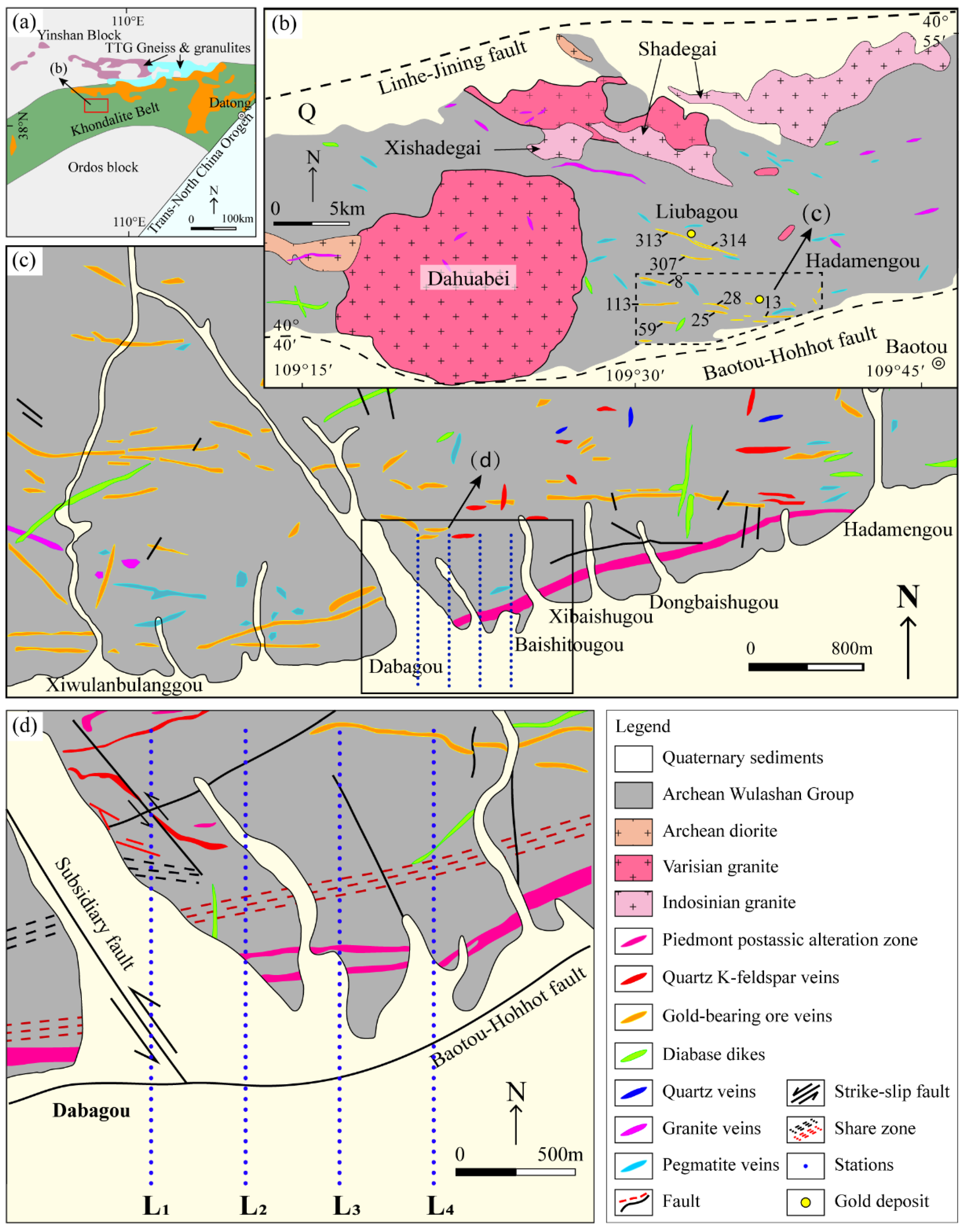

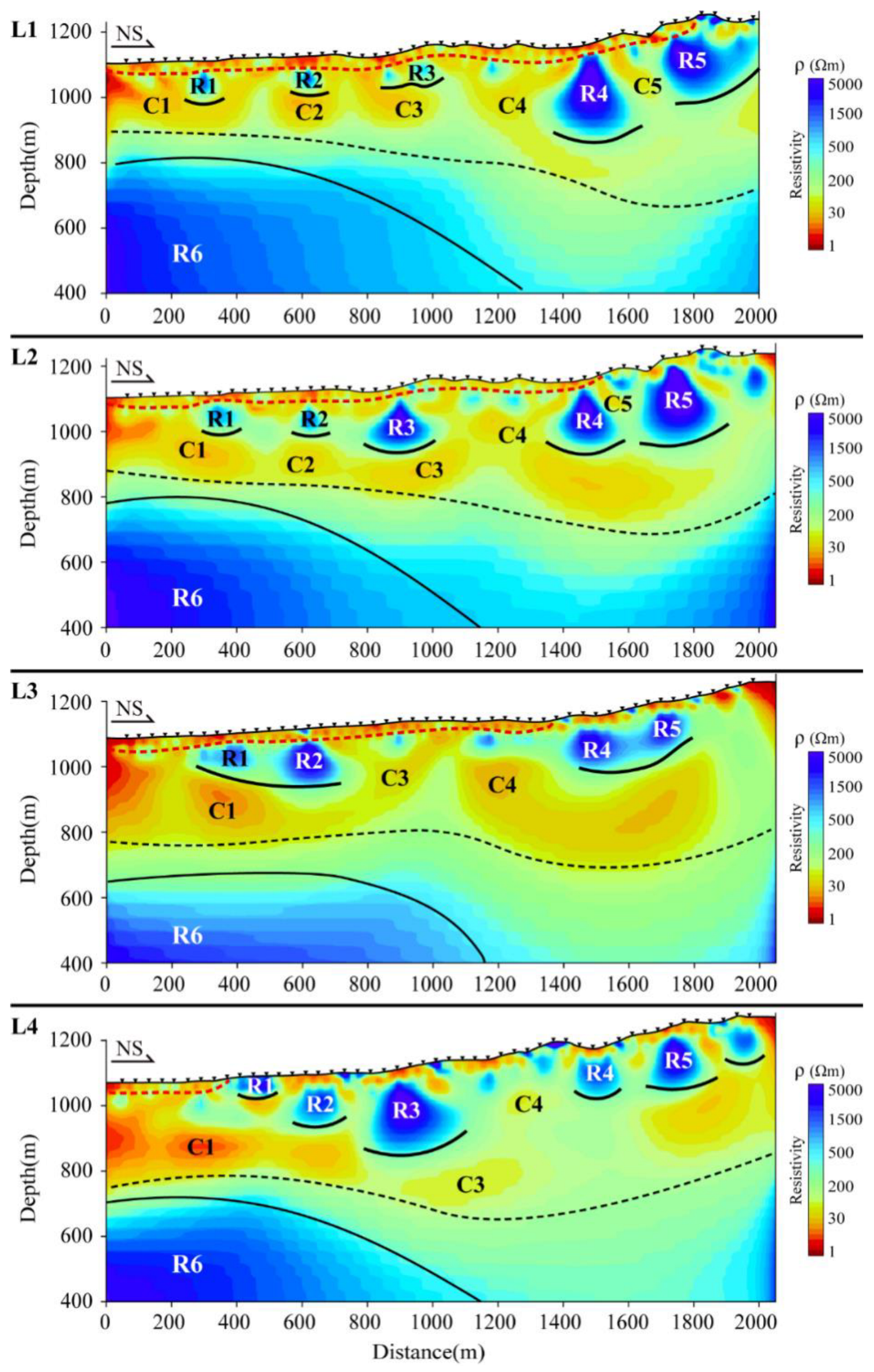
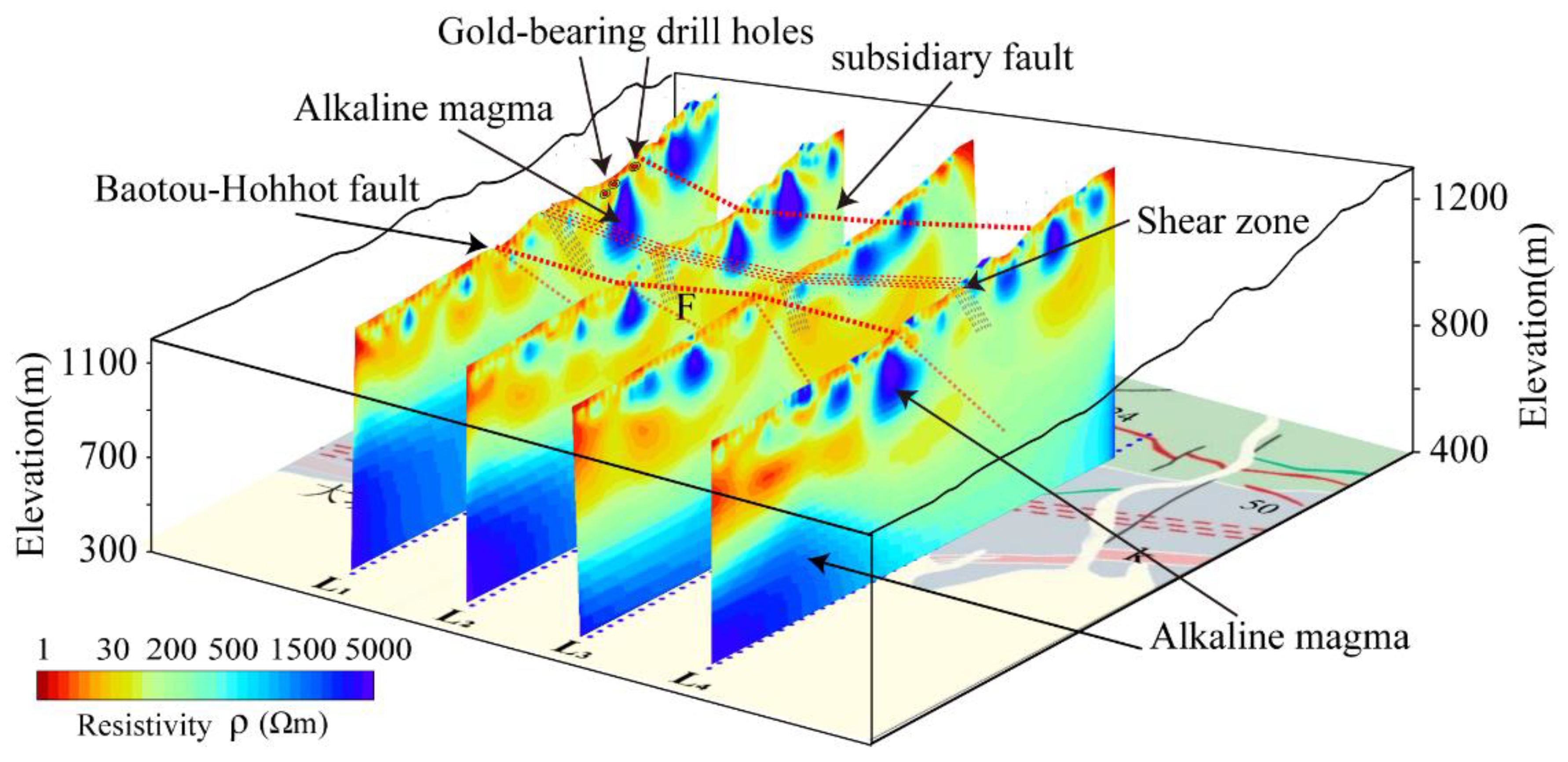
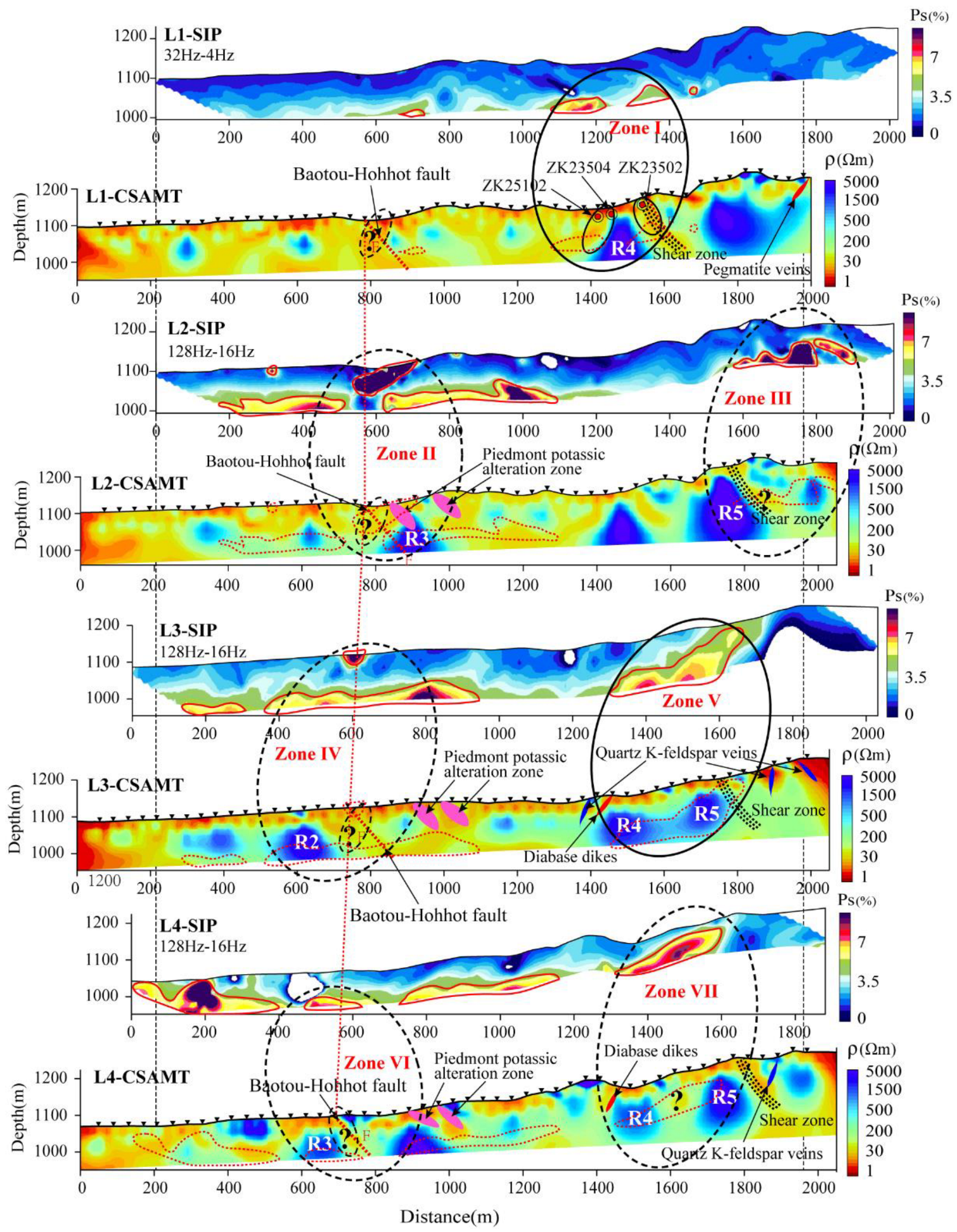
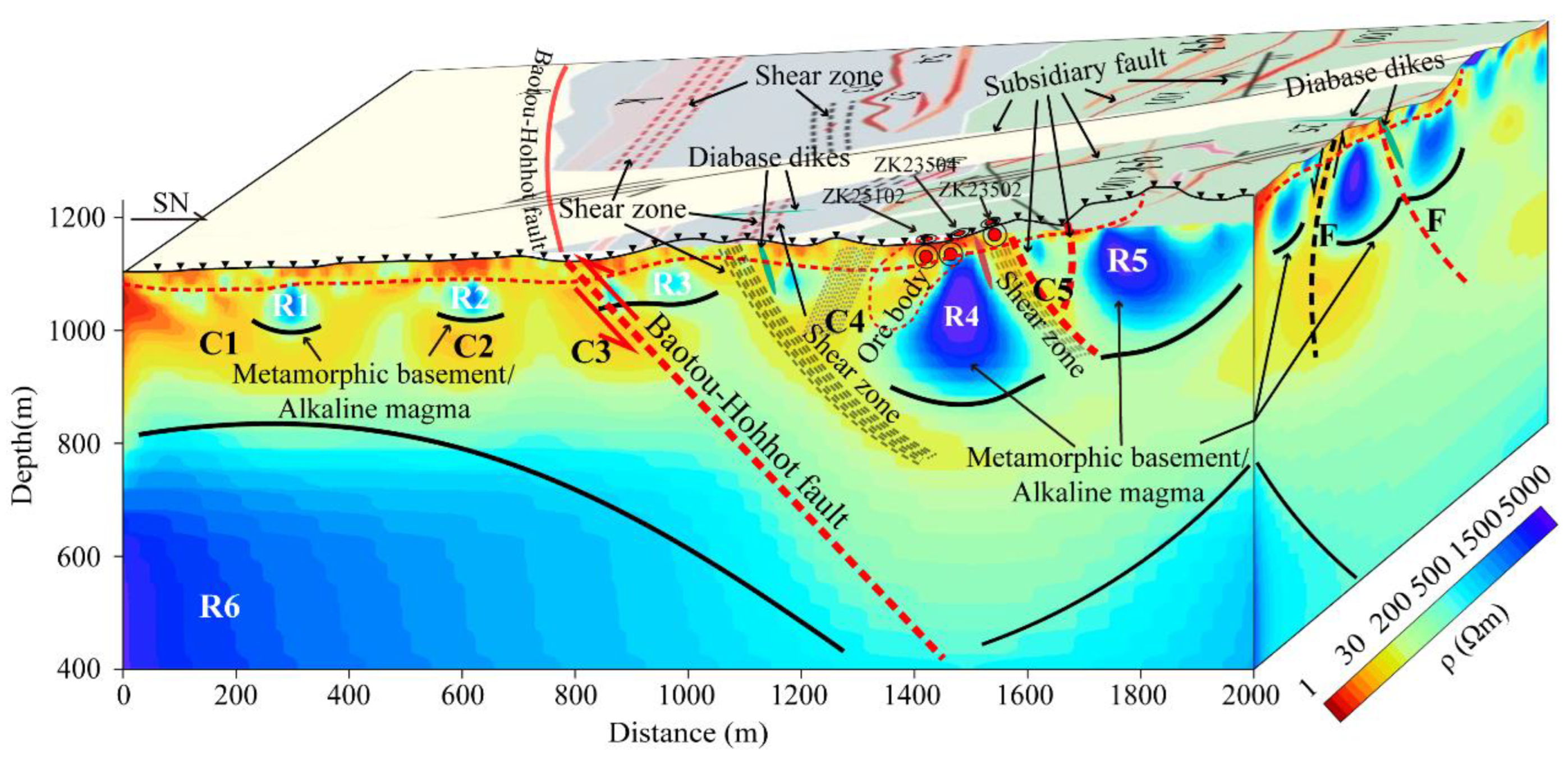
Publisher’s Note: MDPI stays neutral with regard to jurisdictional claims in published maps and institutional affiliations. |
© 2022 by the authors. Licensee MDPI, Basel, Switzerland. This article is an open access article distributed under the terms and conditions of the Creative Commons Attribution (CC BY) license (https://creativecommons.org/licenses/by/4.0/).
Share and Cite
Lv, H.; Xu, L.; Yang, B.; Su, P.; Xu, H.; Wang, H.; Yao, C.; Su, P. Mineralization Based on CSAMT and SIP Sounding Data: A Case Study on the Hadamengou Gold Deposit in Inner Mongolia. Minerals 2022, 12, 1404. https://doi.org/10.3390/min12111404
Lv H, Xu L, Yang B, Su P, Xu H, Wang H, Yao C, Su P. Mineralization Based on CSAMT and SIP Sounding Data: A Case Study on the Hadamengou Gold Deposit in Inner Mongolia. Minerals. 2022; 12(11):1404. https://doi.org/10.3390/min12111404
Chicago/Turabian StyleLv, Hanqin, Liuyang Xu, Biao Yang, Panyun Su, Haoqing Xu, Hailong Wang, Chuan Yao, and Peng Su. 2022. "Mineralization Based on CSAMT and SIP Sounding Data: A Case Study on the Hadamengou Gold Deposit in Inner Mongolia" Minerals 12, no. 11: 1404. https://doi.org/10.3390/min12111404





